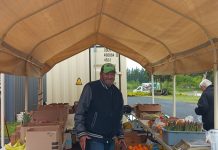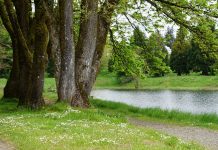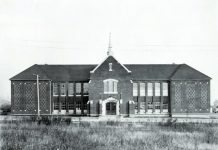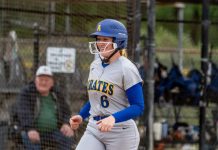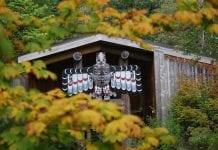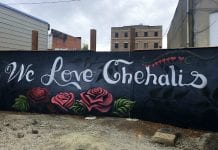In many small towns across the nation, the local school is at the heart of the community – a source of town pride. So what happens when the school closes and children are bussed elsewhere? In Packwood, you take lemons and make lemonade by developing the former Packwood Elementary School into a gem of a museum.
 My children and I were given a tour of the White Pass Country Historical Museum by Society President Janice Grose and Treasurer Martha Garoutte. Martha was quick to show the children hands-on activities throughout the museum.
My children and I were given a tour of the White Pass Country Historical Museum by Society President Janice Grose and Treasurer Martha Garoutte. Martha was quick to show the children hands-on activities throughout the museum.
The trouble began with job loss. About one-third of students had parents working with The Forest Service and some with Department of Natural Resources. The other half were mill workers. The closure of Packwood’s mill in 1998 meant about 360 workers lost their jobs, not to mention the effected loggers and truck drivers that were contracted with the mill.

According to Grose, In the late 1960s and 1970s the Forest Service employed large summer trail and fire crews. But over the years, employment has declined and the Packwood and Randle Ranger Stations were consolidated into the Cowlitz Valley Ranger Station.
Consequently, the permanent population of Packwood shrank.
When Grose, who was a former Packwood Elementary School teacher, left Packwood to teach in Fairbanks, Alaska, the Elementary School had approximately 150 students. Upon her return to Packwood, there were only 65 students remaining. Glenoma School, which closed on the same day as Packwood, was down to 78 students.

Historically, there have been only three schools in Packwood or what was known in the early days as the town of Lewis. In around 1908 or 1909, a log cabin school was erected on land donated by the Combs family. The “White School” was built in 1912 to accommodate a growing student body. In 1930, because of postal confusion between the town Lewis and Fort Lewis, the town was renamed Packwood. The Packwood Elementary School was built in 1938 and housed Kindergarten through 6th grade. The school closed in 2004 and now kids are bussed to Randle’s White Pass Elementary School – an hour-long bus ride.
The White Pass Country Historical Society was formed in response to the school’s closure.
“We knew that the school district was putting the school up for sale,” explained Janice Grose. “A group of us got together and our goal was to establish a museum but we had to jump through all the hoops of becoming a non-profit. We put in our bid and moved in August of 2007.”

In addition to building restoration, the historical society set about creating an inventory of historic artifacts with only three display cases borrowed from the Lewis County Historical Museum. Many of the items in the museum were initially on loan but over the years the collection has grown to fill five classrooms as well as displays in the hallway.
“Our goal is to cover from the Edge of Kosmos up to the top of White Pass, over to Ashford,” says Grose.
“We try to show how people supported themselves, what they needed to do to live on a homestead and survive.”
There is much to see relating to life in the pioneer days of Packwood. It was a rugged few who survived in the mountains. It wasn’t until 1886 that the first family with children arrived in the area, whereas families with children had lived in the low lands of Lewis County since the 1840s. Pack saddles for transporting supplies, pans for panning gold and logging paraphernalia represent early industry in the area. There are two displays that are especially interesting to tourists: the display on Native Americans including local legend Mary Kiona, and the information on the eruption of Mount Saint Helens.

“You can get up close and personal with old maps, bear skins and quilts,” says Grose.
As we walk, the floors of the old school squeak in a satisfying way. The kids try out a rotary phone, which they had never seen before. They’re surprised to find they can lift a large pumice stone from the Mount Saint Helens exhibit. And they’re given tiny magnifying glasses to explore the collection of Russ Gibbs who was a local artist, collector and friend of the Museum.
One room honors the building’s history as a school with memorabilia from Packwood, Randle and Glenoma, including Glenoma’s “Board of Knowledge” which was used as a paddle. The Museum is collecting class pictures, as none existed in the school from 1938 to today. Folks are encouraged to bring in photos to scan.
The Museum’s goal is to be a repository for archives. Before it opened, the only place for archives was the Lewis County Historical Museum, which is quite a distance from the White Pass area. The White Pass Country Historical Society is also making a difference by partnering on historic projects throughout the region.

They are helping to restore High Rock Lookout in cooperation with the United States Forest Service and the Forest Fire Lookout Association. There’s also the La Wis Wis Guard Station Restoration in partnership with the United States Forest Service.
Rob Jeter had La Wis Wis placed on the Passport in Time program, which helped take the dilapidated building back to its unique 1937 depression-era charm. Though there’s still work to do on the interior, the exterior is reminiscent of something one might stumble across in a fairy tale.
Other Historical Society projects and partnerships are:
- The Glenoma School Memorial Arch which features the school’s 1932 portico.
- Restoration of a 1930 Ford Model AA School Bus used in the White Pass School District. This bus is used in parades and is occasionally parked in front of the museum as an attraction.
- Packwood Cultural Council which provides a place for local artists to display works.
If you’re interested in visiting the White Pass Country Historical Museum, check out their calendar to find interesting programs and events throughout the year.





